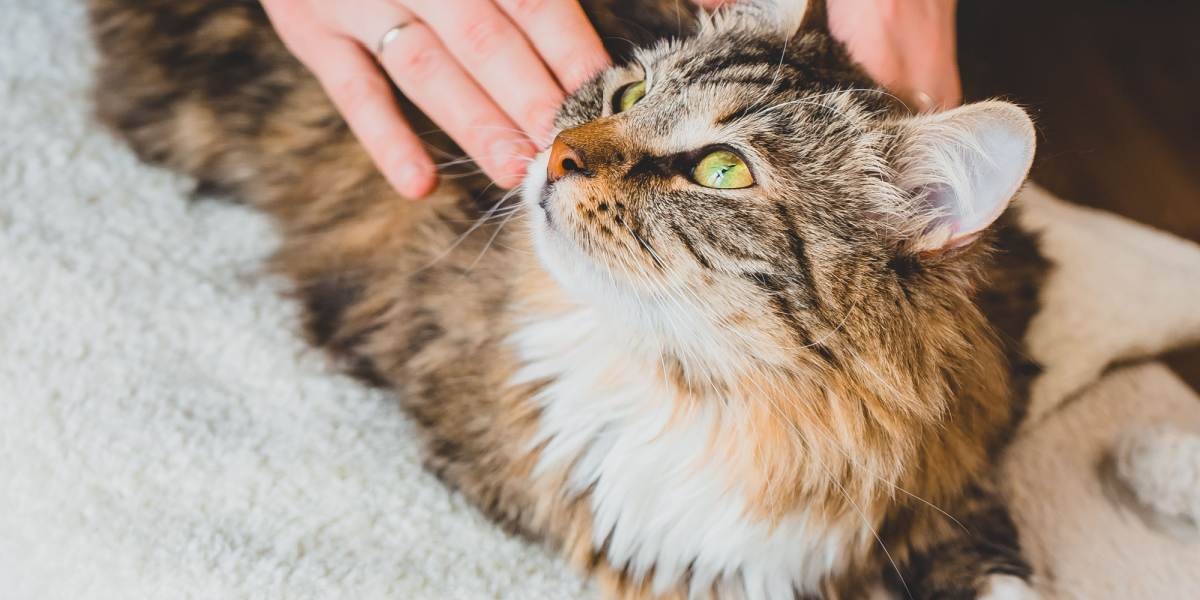Have you ever been petting your feline friend and noticed their back muscles twitching or rippling beneath your hand? It can be a curious sight, sometimes even a little unsettling if you’re unsure what it means. Rest assured, in many cases, these little twitches are perfectly normal. Cats possess a highly sensitive layer of muscle along their backs, making them incredibly responsive to touch. Occasional, mild twitches are often just a natural reaction, but it’s important to understand when these movements might signal something more significant.
Decoding Your Cat’s Twitchy Back: Normal Reactions vs. When to Worry
Understanding why your cat’s back twitches involves recognizing the difference between normal feline behavior and potential underlying health issues. Let’s delve into the common reasons behind these muscle spasms and when it’s time to seek veterinary advice.
Normal Feline Behavior: The Sensitive Cutaneous Trunci Muscle
One of the primary reasons for back twitching in cats lies in their unique anatomy. Cats have a thin, expansive muscle layer called the cutaneous trunci that stretches across their back and flanks. This muscle is incredibly sensitive and reactive. Think of it as a highly tuned sensory organ just beneath the skin.
- Response to Stimuli: This muscle can twitch and ripple in response to various stimuli. When you pet your cat, especially along their back, you’re directly stimulating this muscle. The twitching can simply be a reaction to the physical sensation of touch, much like how we might shiver when something tickles us.
- Emotional Expression: Beyond physical touch, the cutaneous trunci muscle can also react to a cat’s emotional state. Excitement, anticipation (like spotting a bird outside), or even mild irritation can cause these muscles to move. These twitches can be subtle forms of feline communication, expressing their inner feelings through body language.
- Communication: Cats are masters of subtle communication. Those little back twitches can be part of their complex repertoire of body language, signaling their mood or intentions to you or other animals in their environment.
In these instances, occasional and mild back twitching is nothing to worry about. It’s just your cat being a cat!
Potential Medical Reasons for Twitching and Spasms
While normal muscle sensitivity explains many cases of back twitching, there are times when these spasms can indicate an underlying medical condition. If you notice more pronounced, frequent, or concerning twitching, it’s essential to consider these potential health issues:
1. Pain and Discomfort
Just like humans, cats can experience muscle spasms in response to pain. If your cat is experiencing pain in their back, limbs, or tail, muscle twitching can be a reflex reaction.
-
Sources of Pain: This pain could stem from various conditions, including:
- Arthritis: Joint pain, especially in older cats, can lead to muscle spasms as they try to compensate for discomfort.
- Injuries: Wounds, abscesses, or nerve damage can all cause localized pain and muscle twitching.
- Anal Gland Issues: Problems with their anal glands can cause pain and irritation around their rear and back, leading to twitching.
- Internal Pain: While less directly related to back twitching, pain in the abdomen or other areas can sometimes manifest as generalized muscle sensitivity.
-
Accompanying Signs: If pain is the cause, you might notice other signs alongside twitching, such as:
- Limping or Changes in Mobility: Difficulty moving or favoring a limb.
- Increased Vocalization: Meowing or crying more than usual.
- Hiding or Withdrawal: Becoming less social and seeking secluded spots.
- Loss of Appetite: Eating less or refusing food.
- Changes in Grooming Habits: Overgrooming or neglecting grooming, especially in a specific area.
If you suspect your cat is in pain, a veterinary check-up is crucial to identify and address the source of their discomfort.
2. Skin Diseases and Irritations
Skin problems can also trigger muscle twitching. Many dermatological conditions cause itching and irritation, which can manifest as muscle spasms as the cat reacts to the discomfort.
-
Itchy Skin Conditions: Various skin issues can lead to itching (pruritus), including:
- Parasites: Fleas, mites, and other external parasites are common culprits, causing intense itching and irritation. Flea Allergy Dermatitis (FAD), a reaction to flea saliva, is particularly notorious for causing itchy skin, especially along the back and tail base.
- Infections: Fungal or bacterial skin infections can lead to inflammation, itching, and discomfort.
- Allergies: Environmental or food allergies can manifest as skin irritation and itching.
-
Visible Skin Changes: In addition to twitching, skin conditions often present with other visible signs:
- Excessive Scratching and Licking: Frantic attempts to relieve itching.
- Hair Loss (Alopecia): Bald patches or thinning fur.
- Rashes and Redness: Inflamed and irritated skin.
- Scabs and Lesions: Open sores or crusted areas from scratching.
If you observe these skin changes along with back twitching, a vet visit is recommended to diagnose and treat the underlying skin condition.
3. Seizure Activity
While dramatic, full-body seizures (grand mal seizures) are easily recognizable, cats can also experience subtle seizure types known as petit mal or absence seizures. These less obvious seizures can manifest as muscle twitching or spasms.
- Subtle Seizure Signs: Petit mal seizures can be easy to miss but may include:
- Localized Muscle Twitching: Twitching in specific muscle groups, including the back.
- Spasms: Involuntary muscle contractions.
- Vacant Stare: A blank or unfocused gaze.
- Rapid Blinking: Unusually fast eye blinking.
- Changes in Awareness: Brief periods of unresponsiveness or confusion.
If you suspect your cat might be having subtle seizures, it’s crucial to consult your veterinarian for a neurological evaluation.
4. Feline Hyperesthesia Syndrome (FHS)
Feline Hyperesthesia Syndrome (FHS), also known as rippling skin syndrome or twitchy cat disease, is a more complex and less understood neurological condition. It’s characterized by heightened skin sensitivity and can cause dramatic back twitching and rippling.
-
Key Symptoms of FHS:
- Rippling Skin: A wave-like motion of the skin along the back, often near the tail base.
- Extreme Sensitivity to Touch: Even light petting can trigger exaggerated reactions, sometimes including biting or hissing.
- Frantic Licking and Biting: Obsessive grooming, especially directed at their back, flanks, and limbs.
- Tail Chasing: Compulsively chasing and biting their tail.
- Erratic Behavior: Sudden bursts of energy, running, and jumping around.
- Dilated Pupils: Enlarged pupils, indicating heightened arousal or anxiety.
- Behavioral Changes: Increased anxiety, restlessness, and vocalization.
- Seizures (Rare): In some cases, seizures can occur.
-
Understanding FHS: The exact cause of FHS remains unclear, but it’s thought to involve neurological or psychological factors. Certain breeds, like Siamese, Persian, and Abyssinian cats, may be predisposed. Diagnosis often involves ruling out other potential causes.
If your cat exhibits several of these FHS symptoms, especially the characteristic rippling skin, veterinary investigation is essential.
5. Hyperthyroidism
While hyperthyroidism (overactive thyroid gland) is primarily known for symptoms like increased appetite, weight loss, and hyperactivity, it can also manifest in less typical ways, including muscle twitching.
- Hyperthyroidism and Muscle Twitching: The hormonal imbalances caused by hyperthyroidism can sometimes affect muscle function and lead to tremors or twitching.
- Other Hyperthyroidism Signs: Classic symptoms to watch for include:
- Increased Appetite: Eating significantly more but still losing weight.
- Increased Thirst and Urination: Drinking and urinating more frequently.
- Weight Loss: Despite increased appetite.
- Hyperactivity and Restlessness: Increased energy levels and agitation.
- Poor Coat Condition: Unkempt or matted fur.
If your cat displays these broader symptoms alongside back twitching, hyperthyroidism should be considered and discussed with your vet.
When to Consult Your Veterinarian
Occasional, mild back twitches are usually not a cause for concern. However, it’s essential to be vigilant and seek veterinary advice if you observe any of the following:
- Frequent or Intense Twitching: If the twitching becomes more frequent, prolonged, or intense.
- Rippling Skin: The characteristic wave-like motion of the skin associated with FHS.
- Accompanying Symptoms: Any other signs of illness or discomfort, such as:
- Excessive Licking, Scratching, or Biting.
- Hair Loss, Rashes, or Skin Lesions.
- Changes in Behavior, Appetite, or Energy Levels.
- Limping or Difficulty Moving.
- Increased Vocalization or Hiding.
- Sensitivity to Touch or Aggression When Pet.
Your veterinarian will conduct a thorough physical examination and may recommend diagnostic tests like bloodwork, skin scrapings, or imaging to determine the underlying cause of your cat’s back twitching.
Treatment Options
Treatment will depend entirely on the diagnosis.
- Parasites: Anti-parasitic medications effectively treat fleas, mites, and other external parasites.
- Pain Management: Analgesics and anti-inflammatory drugs can help manage pain from arthritis, injuries, or other painful conditions.
- Seizure Control: Anti-epileptic medications can manage seizure disorders.
- FHS Management: FHS treatment is often multifaceted and may involve stress reduction, environmental enrichment, dietary changes, and medications like gabapentin or phenobarbital to manage symptoms.
- Hyperthyroidism: Treatment options include medication, radioactive iodine therapy, or surgery to manage the overactive thyroid.
In Conclusion
While a twitchy back in cats can sometimes be a normal quirk of feline anatomy and behavior, it’s crucial to be aware of when it might signal a more significant health problem. By observing your cat closely and recognizing the difference between normal twitches and potentially concerning symptoms, you can ensure your furry companion receives the appropriate care and stays happy and healthy. When in doubt, always err on the side of caution and consult with your veterinarian.
Related Conditions
- Feline Hyperesthesia Syndrome
- Seizures in Cats
- Skin Diseases in Cats
- Pain Management in Cats
- Hyperthyroidism in Cats
Frequently Asked Questions
Why is my cat’s back twitching?
Occasional back twitching is often normal due to the sensitive cutaneous trunci muscle. However, persistent or severe twitching can be caused by pain, skin disease, parasites, neurological issues like feline hyperesthesia syndrome, or hyperthyroidism.
Why does my cat’s back ripple?
Back rippling, or rippling skin syndrome, is a hallmark sign of feline hyperesthesia syndrome, a neurological condition causing heightened skin sensitivity and other behavioral changes.
Is feline hyperesthesia common?
Feline hyperesthesia syndrome is considered relatively rare in cats. It’s more frequently diagnosed in young adult cats and certain breeds like Siamese, Persian, and Abyssinian.


